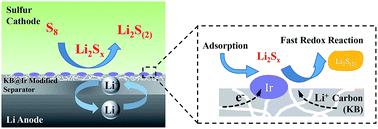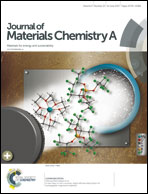Facilitating the redox reaction of polysulfides by an electrocatalytic layer-modified separator for lithium–sulfur batteries†
Abstract
Although physical confinement and chemical adsorption have been adopted for trapping sulfur species within cathodes, there still exist some drawbacks, including low charge/discharge coulombic efficiency and unsatisfied cycleability in terms of the slow kinetic process of polysulfide conversion. Herein, we propose a KB@Ir-modified separator with a catalytic layer to facilitate the redox reaction of polysulfide intermediates and to achieve improved electrochemical performance in lithium sulfur batteries. The iridium nanoparticles not only exhibit strong chemical interaction with the polysulfides, but also efficiently accelerate the kinetic process for polysulfide conversion, especially for the reduction of soluble polysulfides towards insoluble Li2S2/Li2S. A high initial capacity of 1508 mA h g−1 along with 90.0% utilization of sulfur could be achieved under a charge/discharge rate of 0.2C. Also the cell showed a low capacity decay rate of 0.105% per cycle over 500 cycles at 1.0C. This strategy from the point of view of electrocatalysis is expected to be effective for achieving high-energy lithium–sulfur batteries with excellent electrochemical performance.



 Please wait while we load your content...
Please wait while we load your content...